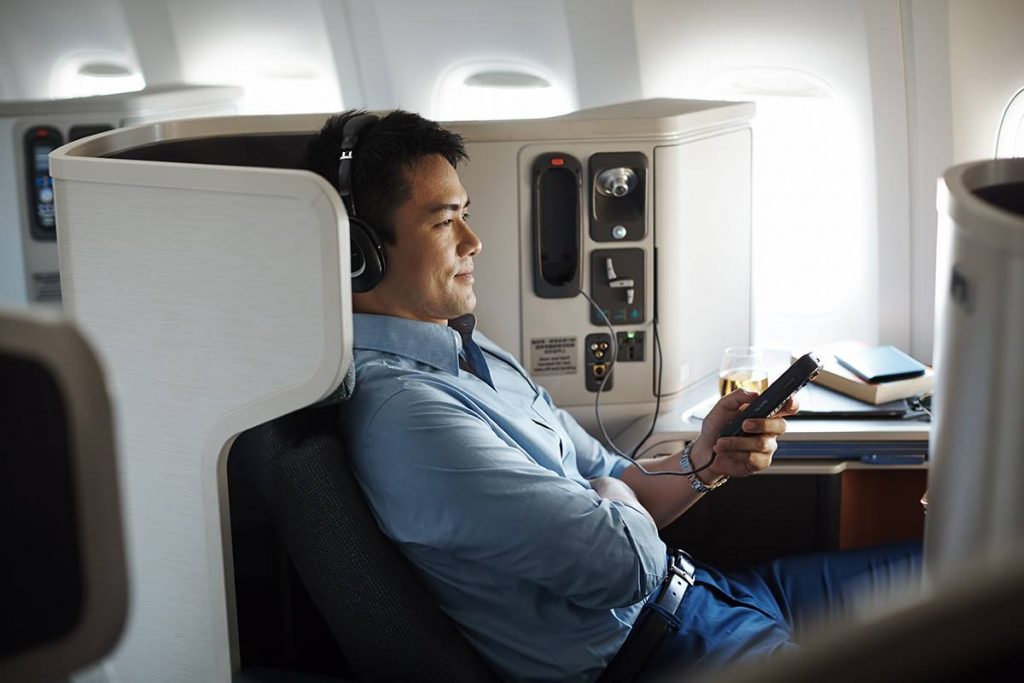Skift Take
As airlines double down on investment in business class, there are some experiential table stakes for customers paying the money to sit up front.
 Colin Nagy, head of strategy at Fred & Farid, a global advertising agency, writes this opinion column for Skift on hospitality, innovation, and business travel. “On Experience” dissects customer-centric experiences and innovation across hospitality, aviation, and beyond.
Colin Nagy, head of strategy at Fred & Farid, a global advertising agency, writes this opinion column for Skift on hospitality, innovation, and business travel. “On Experience” dissects customer-centric experiences and innovation across hospitality, aviation, and beyond.
I wrote recently about the role of first class in the world. Many carriers are emphasizing their dense, moneymaking business-class configurations, and the first-class product is becoming more rare.
It makes sense that they are doubling down, but as a result, there are some new imperatives for first class. It will require more innovation, thinking, and design to justify the price.
All too often today, you can be sitting in a $5,000 dollar seat that doesn’t fully recline to a flat bed, where your meal is served to you in an impersonal assembly line, and where you don’t have aisle access.
Also, for all of the calculated marketing hype behind United’s new business class, Polaris, the cabin makes you feel like you’re a sardine in a tin can. On business configurations that sit on top of the Airbus A380, the rows and rows of other passengers make it feel incredibly impersonal.
The new imperatives for business are:
Privacy and access
There’s nothing less dignified than having to awkwardly climb over a sleeping passenger to stand up. Carriers need to provide direct-aisle access as standard. Configurations that lead the pack today are Qatar’s A350 and the reverse herringbone configurations that like Cathay Pacific run on their 777-300ERs.
Having logged a lot of time in Cathay’s configuration from New York to Hong Kong, it is the most comfortable product going. There’s ample privacy on the single side-angled seats, and the two middle seats work well for people flying together, but also are private enough that you aren’t watching a stranger sleep.
Custom entertainment
How can in-flight entertainment in the front cabin be differentiated from other sections in the plane? This might include interesting curation, early access to films, or a range of thoughtful podcasts.
Also in-flight entertainment doesn’t just mean staring at a screen. Why not a beautiful magazine rack in the lounge area stocked with incredible titles from around the world? Maybe partner with Stack Magazines, a company that champions some of the sharpest, limited-run independent magazines, set alongside the best print newspapers and larger journals?
For long-haul flights when you’ve cleared your inbox, watched a few films and read something digitally, the printed page is a welcome respite. And many of the publishers would love to be in the esteemed company of the passengers in the front of the plane on a great carrier.
Freedom to eat when you want
Anyone who has flown British Airways’ old Club World has seen the grim, assembly line meal service, about as personal as a Greyhound bus. The airline has thankfully changed its approach, but carriers should look to emulate the dine-on demand service that Etihad and Qatar take. You can eat when you want, and not be locked into the typical cadence. There’s flexibility and freedom to sequence the flight as you want. Also, regular business travelers deserve a light, fresh option because not eating heavily helps with jet lag.
Seamless check-in without a wait
Despite easy digital apps and improved services on the mobile phone, physical check-in is still necessary when you’re checking bags or need to handle logistics. This is an important touch point for first impressions, but many carriers have outsourced this to agents that work for multiple airlines throughout the day and don’t represent the brand.
Also, there’s nothing worse than paying top-dollar for a ticket only to join a long, bloated line of fellow travelers because staffing was incorrect. Airlines know when flights are leaving, when people check in, and how many people should be on hand. Anything else is a letdown.
Flat beds
It should go without saying, but there are far too many seats in the sky that are not actually flat on long-haul flights: the dreaded angled seat that makes legs go numb and sleep awkward.
Again, travelers should be educated on the products they choose to spend their money on by doing a bit of due diligence. But airlines also need to live up to their end of the bargain when it comes to updating old, natty seats, and inferior products.
Cleanliness
There’s nothing worse than a crumb-laden, dirty cabin. Carriers should resolve to provide a pristine environment for their business travelers. You’d be surprised how often this is not the case.
Wi-fi
Though I yearn for the days of an uninterrupted, long-haul flight filled with books, magazines and relaxation, speedy wi-fi is a business imperative. A service that is reliable and doesn’t require 17 painful steps to connect.
Thoughtful bedding
American Airlines gets kudos for tying up with Casper to provide in-flight amenities, a down comforter, pillows and more. It is not just a partnership, it is a culturally astute signal that the airline is aligning with a new, entrepreneurial and ostensibly customer-centric company. For overnight flights, a mattress cover, duvet, pillow are all table stakes. Bonus points for airlines like JAL which provide a perfect Airweave mattress to soften the bed for a better night’s sleep.
The Daily Newsletter
Our daily coverage of the global travel industry. Written by editors and analysts from across Skift’s brands.
Have a confidential tip for Skift? Get in touch
Tags: airline innovation, business class, cathay pacific, first class, On Experience, qatar, united airlines
Photo credit: Business class configurations that enable direct-aisle access are a must. Pictured is business class on a Cathay Pacific flight on September 21, 2017. Cathay Pacific
